Rubberwood—Potential for Pulp and Composite Board Utilization
Abstract
:1. Introduction
2. Materials and Methods
2.1. Measurement of Fibre Dimensions
2.2. Data Analysis
3. Results and Discussion
3.1. Fibre Length
3.2. Lumen Width
3.3. Fibre Diameter
3.4. Fibre Wall Thickness
3.5. Slenderness Ratio
3.6. Flexibility Ratio
3.7. Runkel Ratio
3.8. Fibre Properties of Rubberwood Compared with Other Tropical Wood Species
4. Conclusions
Author Contributions
Funding
Data Availability Statement
Conflicts of Interest
References
- Ogunsanwo, O.Y. Effective Management of Wood Waste for Sustainable Wood Utilization in Nigeria. In Proceedings of the 27th Annual Conference of Forestry Association of Nigeria. FCT 17-21, Abuja, Nigeria, 17–21 September 2001; pp. 225–234. [Google Scholar]
- Onakpoma, I. Wood Properties of Tapped Rubber Tree (Hevea brasiliensis Muell. Arg.) in Agbarha, Delta State, Nigeria. Ph.D. Thesis, Department of Forest Resources Management, University of Ibadan, Ibadan, Nigeria, 2019. [Google Scholar]
- Oluwadare, A.O. Wood Properties and Selection for Rotation Length in Caribbean Pine (Pinus caribaea Morelet) Grown in Afaka, Nigeria. Am. J. Agric. Environ. Sci. 2007, 2, 359–363. [Google Scholar]
- Oluwadare, A.O.; Sotannde, O.A. The Relationship between Fibre Characteristics and Pulp-Sheet Properties of Leucaena leucocephala (Lam.) De Wit. Middle-East J. Sci. Res. 2007, 2, 63–68. [Google Scholar]
- Ogunkunle, A.T.J. A Quantitative Modelling of Pulp and Paper Making Suitability of Nigerian Hardwood Species. Adv. Nat. Appl. Sci. 2010, 4, 14–21. [Google Scholar]
- Izekor, D.N.; Fuwape, J.A. Variations in the Anatomical Characteristics of Plantation Grown Tectona grandis Wood in Edo State, Nigeria. Arch. Appl. Sci. Res. 2011, 3, 83–90. [Google Scholar]
- Emerhi, E.A. Variations in Anatomical Properties of Rhizophora racemosa (Leechm) and Rhizophora harrisonni (G.Mey) in a Nigerian Mangrove Forest Ecosystem. Int. J. For. Soil Eros. 2012, 2, 89–96. [Google Scholar]
- Ogunleye, M.M.; Fuwape, J.A.; Oluyege, A.O.; Ajayi, B.; Fabiyi, J. Evaluation of Fiber Characteristics of Ricinodedron heudelotti (Baill, Pierre Ex Pax) for Pulp and Paper Making. Int. J. Sci. Technol. 2017, 6, 2–5. [Google Scholar]
- Riki, J.T. Wood Quality Studies of Some Hardwood Species in University of Ibadan, Ibadan, Nigeria. Master’s Thesis, Department of Forest Production and Products, University of Ibadan, Ibadan, Nigeria, 2018. [Google Scholar]
- Huang, Y.; Fei, B. Comparison of the Mechanical Characteristics of Fibers and Cell Walls from Moso Bamboo and Wood. BioResources 2017, 12, 8230–8239. [Google Scholar] [CrossRef]
- Onakpoma, I.; Oluwadare, O.A.; Amusan, T.A. Fibre Characteristics of Agave sisalana for Pulp and Paper Production. ProLigno 2019, 15, 25–29. [Google Scholar]
- Robertson, N.L.M.; Nychka, J.A.; Alemaskin, K.; Wolodko, J.D. Mechanical Performance and Moisture Absorption of Various Natural Fiber Reinforced Thermoplastic Composites. J. Appl. Polym. Sci. 2013, 130, 969–980. [Google Scholar] [CrossRef]
- Thyavihalli Girijappa, Y.G.; Mavinkere Rangappa, S.; Parameswaranpillai, J.; Siengchin, S. Natural Fibers as Sustainable and Renewable Resource for Development of Eco-Friendly Composites: A Comprehensive Review. Front. Mater. 2019, 6, 226. [Google Scholar] [CrossRef]
- Ramawat, K.G.; Ahuja, M.R. Fiber Plants: An Overview. In Fiber Plants, Sustainable Development and Biodiversity; Ramawat, K.G., Ahuja, M.R., Eds.; Springer International Publishing: Cham, Switzerland, 2016; pp. 3–15. ISBN 9783319445700. [Google Scholar]
- Balsiger, J.; Bahdon, J.; Whiteman, A. The Utilization, Processing and Demand for Rubberwood as a Source of Wood Supply. Asia-Pacific Forestry Sector Outlook Study Working Paper Series No: 50; APFSOS/WP/50; FAO Regional Office for Asia and the Pacific: Bangkok, Thailand, 2000. [Google Scholar]
- Teoh, Y.P.; Don, M.M.; Ujang, S. Assessment of the Properties, Utilization, and Preservation of Rubberwood (Hevea brasiliensis): A Case Study in Malaysia. J. Wood Sci. 2011, 57, 255–266. [Google Scholar] [CrossRef]
- Onakpoma, I.; Ogunsanwo, O.Y.; Ohwo, O.A.; Schimleck, L.; Leavengood, S. Effect of Tapping Duration on Specific Gravity and Shrinkage of Rubberwood. Maderas Cienc. Y Tecnol. 2023. submitted. [Google Scholar]
- Bisong, B.; Asim, I.; Edem, E.; Ayuk, E. Ecological Characteristics of Para Rubber (Hevea brasiliensis Muell. Arg) Productivity in the Niger Delta Region of Nigeria. Int. J. Plant Soil Sci. 2017, 14, 1–10. [Google Scholar] [CrossRef]
- Ohwo, O.A.; Onakpoma, I.; Okoromaraye, E. Evaluation of Properties of Graded Density Fibreboard Produced from Wood Residues (Sawdust and Corrugated Paper). Balt. For. 2020, 26, 494. [Google Scholar] [CrossRef]
- Abara Mangasha, L. Review on Effect of Some Selected Wood Properties on Pulp and Paper Properties. J. For. Environ. 2019, 1, 16–22. [Google Scholar]
- Franklin, G. Preparation of Thin Sections of Synthetic Resins and Wood-Resin Composites, and a New Macerating Method for Wood. Nature 1945, 155, 51–55. [Google Scholar] [CrossRef]
- Pulkkinen, I.; Ala-Kaila, K.; Aittamaa, J. Characterization of Wood Fibers Using Fiber Property Distributions. Chem. Eng. Process. 2006, 45, 546–554. [Google Scholar] [CrossRef]
- Amuthakkannan, P.; Manikandan, V.; Winowlin Jappes, J.T.; Uthayakumar, M. Effect of Fibre Length and Fibre Content on Mechanical Properties of Short Basalt Fibre Reinforced Polymer Matrix Composites. Mater. Phys. Mech. 2013, 16, 107–117. [Google Scholar]
- Thumm, A.; Dickson, A.R. The Influence of Fibre Length and Damage on the Mechanical Performance of Polypropylene/Wood Pulp Composites. Compos. Part A Appl. Sci. Manuf. 2013, 46, 45–52. [Google Scholar] [CrossRef]
- Jun, L.S.; Zhang, S.Y.; Riedl, B. Multivariate Modeling of MDF Panel Properties in Relation to Wood Fiber Characteristics. Holzforschung 2006, 60, 285–293. [Google Scholar] [CrossRef]
- Niskanen, K. Paper Physics; TAPPI Press: Vancouver, BC, Canada, 1998. [Google Scholar]
- Ona, T.; Sonoda, T.; Ito, K.; Shibata, M.; Tamai, Y.; Kojima, Y.; Ohshima, J.; Yokota, S.; Yoshizawa, N. Investigation of Relationships between Cell and Pulp Properties in Eucalyptus by Examination of Within-Tree Property Variations. Wood Sci. Technol. 2001, 35, 229–243. [Google Scholar] [CrossRef]
- Tembe, E.T.; Amonum, J.I.; Shomkegh, S.A. Variations in the Fibre Length of Rubber Wood (Hevea brasiliensis (Kunth) Muel Arg) Grown in South Eastern Nigeria. J. Res. For. Wildl. Environ. 2010, 2, 214–220. [Google Scholar]
- Boerhendy, H.I.; Agustina, D.S.; Suryaningtyas, H. Basic Characteristics of Rubberwood for Some Recommended Clones in Indonesia; Sembawa Research Center Indonesia Rubber Research Institute: Palembang, Indonesia, 2010. [Google Scholar]
- Naji, H.R.; Sahri, M.H.; Nobuchi, T.; Bakar, E.S. Clonal and Planting Density Effects on Some Properties of Rubber Wood (Hevea brasiliensis Muell. ARG.). BioResources 2012, 7, 189–202. [Google Scholar] [CrossRef]
- Norul Izani, M.A.; Sahri, M.H. Wood and Cellular Properties of Four New Hevea Species. In Proceedings of the FORTROP II International Conference, Bangkok, Thailand, 17–20 November 2008. [Google Scholar]
- Suhaimi, M.; Sahri, M.H. Variation in Fibre Properties of Rubberwood from Different Clones and Age Groups. J. Trop. For. Prod. 2003, 9, 162–165. [Google Scholar]
- Haifah, S. Anatomical and Fibre Properties of Hybrid Acacia Grown in Sabah. Ph.D. Thesis, Faculty of Forestry, University of Putra Malaysia, Serdang, Malaysia, 2002. [Google Scholar]
- Shupe, T.F.; Choong, E.T.; Stokke, D.D.; Gibson, M.D. Variation in Cell Dimensions and Fibril Angle for Two Fertilized Even-Aged Loblolly Pine Plantations. Wood Fiber Sci. 1996, 28, 268–275. [Google Scholar]
- Jorge, F.; Quilhó, T.; Pereira, H. Variability of Fibre Length in Wood and Bark in Eucalyptus globulus. IAWA J. 2000, 21, 41–48. [Google Scholar] [CrossRef]
- Ogunsanwo, O.Y. Characterization of Wood Properties of Plantation Grown Obeche (Triplochiton scleroxylon) in Omo Forest Reserve, Ogun State. Ph.D. Thesis, Department of Forest Resources Management, University of Ibadan, Ibadan, Nigeria, 2000. [Google Scholar]
- Bao, F.C.; Jiang, Z.H.; Jiang, X.M.; Lu, X.X.; Luo, X.Q.; Zhang, S.Y. Differences in Wood Properties between Juvenile Wood and Mature Wood in 10 Species Grown in China. Wood Sci. Technol. 2001, 35, 363–375. [Google Scholar] [CrossRef]
- Honjo, K.; Furukawa, I.; Sahri, M.H. Radial Variation of Fiber Length Increment in Acacia mangium. IAWA J. 2005, 26, 339–352. [Google Scholar] [CrossRef]
- Walker, J.C.F. Primary Wood Processing: Principles and Practice; Springer: Dordrecht, The Netherlands, 2006; ISBN 9781402043925. [Google Scholar]
- Salehi, K. Study and Determine the Properties of Chemi-Mechanical Pulping High Yields from Bagasse; Wood and Paper Research No. 232; Research Institute of Forests and Rangelands: Tehran, Iran, 2001. [Google Scholar]
- Xing, C.; Riedl, B.; Cloutier, A. Measurement of Urea-Formaldehyde Resin Distribution as a Function of MDF Fiber Size by Laser Scanning Microscopy. Wood Sci. Technol. 2004, 37, 495–507. [Google Scholar] [CrossRef]
- Benthien, J.T.; Bähnisch, C.; Heldner, S.; Ohlmeyer, M. Effect of Fiber Size Distribution on Medium-Denstiy Fiberboard Properties Caused by Varied Steaming Time and Temperature of Defibration Process. Wood Fiber Sci. 2014, 46, 175–185. [Google Scholar]
- Ayrilmis, N.; Akbulut, T.; Yurttaş, E. Effects of Core Layer Fiber Size and Face-to-Face Core Layer Ratio on the Properties of Three-Layered Fiberboard. BioResources 2017, 12, 7964–7974. [Google Scholar] [CrossRef]
- Suchsland, O.; Woodson, G.E. Fiberboard Manufacturing Practices in the United States; No. 640; US Department of Agriculture, Forest Service: Washington, DC, USA, 1987.
- Riki, J.T.B.; Sotannde, O.A.; Oluwadare, A.O. Anatomical and Chemical Properties of Wood and Their Practical Implications in Pulp and Paper Production: A Review. J. Res. For. Wildl. Environ. 2019, 11, 358–368. [Google Scholar]
- Woodson, G.E. Properties of Medium Density Fibreboard Related to Hardwood Specific Gravity. In Proceedings of the 10th Washington State University Particleboard Symposium, Pullman, WA, USA; 1976; pp. 175–192. [Google Scholar]
- Yahaya, M.I.B. Quality Assessment of Two Timber Latex Clones of Rubberwood (Hevea brasiliensis). Master’s Thesis, Faculty of Forestry, University of Putra Malaysia, Serdang, Malaysia, 2001. [Google Scholar]
- NagarajaGanesh, B.; Rekha, B. Intrinsic Cellulosic Fiber Architecture and Their Effect on the Mechanical Properties of Hybrid Composites. Arch. Civ. Mech. Eng. 2020, 20, 125. [Google Scholar] [CrossRef]
- Saffian, H.A.; Tahir, P.M.; Harun, J.; Jawaid, M.; Hakeem, K.R. Influence of Planting Density on the Fiber Morphology and Chemical Composition of a New Latex-Timber Clone Tree of Rubberwood (Hevea brasiliensis Muell. Arg.). BioResources 2014, 9, 2593–2608. [Google Scholar] [CrossRef]
- Zobel, B.J.; van Buijtenen, J.P. Wood Variation: Its Causes and Control; Springer series in wood science; Springer: Berlin/Heidelberg, Germany, 1989; ISBN 038750298X. [Google Scholar]
- Sharma, A.K.; Dutt, D.; Upadhyaya, J.S.; Roy, T.K. Anatomical, Morphological, and Chemical Characterization of Bambusa tulda, Dendrocalamus hamiltonii, Bambusa balcooa, Malocana baccifera, Bambusa arundinacea and Eucalyptus tereticornis. BioResources 2011, 6, 5062–5073. [Google Scholar] [CrossRef]
- Pulkkinen, I.; Alopaeus, V.; Fiskari, J.; Joutsimo, O. The Use of Fibre Wall Thickness Data to Predict Handsheet Properties of Eucalypt Pulp Fibres. O Papel. 2008, 69, 71–85. [Google Scholar]
- Xu, F.; Zhong, X.C.; Sun, R.C.; Lu, Q. Anatomy, Ultrastructure and Lignin Distribution in Cell Wall of Caragana korshinskii. Ind. Crops Prod. 2006, 24, 186–193. [Google Scholar] [CrossRef]
- Arabi, M.; Faezipour, M.; Layeghi, M.; Enayati, A.A. Interaction Analysis between Slenderness Ratio and Resin Content on Mechanical Properties of Particleboard. J. For. Res. 2011, 22, 461–464. [Google Scholar] [CrossRef]
- Maloney, T.M. Modern Particleboard and Dry-Process Fiberboard Manufacturing; Miller Freeman Publication: San Francisco, CA, USA, 1993. [Google Scholar]
- Ayrilmis, N. Effect of Tree Species on Some Mechanical Properties of MDF. J. For. Fac. Istanb. Univ. 2002, 52, 125–146. [Google Scholar]
- Stark, N.M.; Rowlands, R.E. Effects of Wood Fiber Characteristics on Mechanical Properties of Wood/Polypropylene Composites. Wood Fiber Sci. 2003, 35, 167–174. [Google Scholar]
- Kiaei, M.; Tajik, M.; Vaysi, R. Chemical and Biometrical Properties of Plum Wood and Its Application in Pulp and Paper Production. Maderas Cienc. Y Tecnol. 2014, 16, 313–322. [Google Scholar] [CrossRef]
- Smook, G.A. Handbook for Pulp and Paper Technologists; Angus Wilde Publications: Vancouver, BC, Canada, 1997. [Google Scholar]
- Bektaş, I.; Tutuş, A.; Eroǧlu, H. A Study of the Suitability of Calabrian Pine (Pinus brutia Ten.) for Pulp and Paper Manufacture. Turk. J. Agric. For. 1999, 23, 589–597. [Google Scholar]
- Ververis, C.; Georghiou, K.; Christodoulakis, N.; Santas, P.; Santas, R. Fiber Dimensions, Lignin and Cellulose Content of Various Plant Materials and Their Suitability for Paper Production. Ind. Crops Prod. 2004, 19, 245–254. [Google Scholar] [CrossRef]
- Istek, A. Effect of Phanerochaete chrysosporium White Rot Fungus on the Chemical Composition of Populus tremula L. Cellul. Chem. Technol. 2006, 40, 475–478. [Google Scholar]
- Jones, D.; Brischke, C. 2-Wood as Bio-Based Building Material. In Performance of Bio-based Building Materials; Jones, D., Brischke, C., Eds.; Woodhead Publishing: Sawston, UK, 2017; pp. 21–96. [Google Scholar] [CrossRef]
- Zwawi, M. A Review on Natural Fiber Bio-Composites, Surface Modifications and Applications. Molecules 2021, 26, 404. [Google Scholar] [CrossRef]
- Xing, C.; Zhang, S.Y.; Deng, J.; Riedl, B.; Cloutier, A. Medium-Density Fiberboard Performance as Affected by Wood Fiber Acidity, Bulk Density, and Size Distribution. Wood Sci. Technol. 2006, 40, 637–646. [Google Scholar] [CrossRef]
- Harmaen, A.S.; Jalaluddin, H.; Paridah, M.T. Properties of Medium Density Fibreboard Panels Made from Rubberwood and Empty Fruit Bunches of Oil Palm Biomass. J. Compos. Mater. 2013, 47, 2875–2883. [Google Scholar] [CrossRef]
- Sharma, M.; Sharma, C.L.; Kumar, Y.B. Evaluation of Fiber Characteristics in Some Weeds of Arunachal Pradesh, India for Pulp and Paper Making. Res. J. Agric. For. Sci. 2013, 1, 15–21. [Google Scholar]
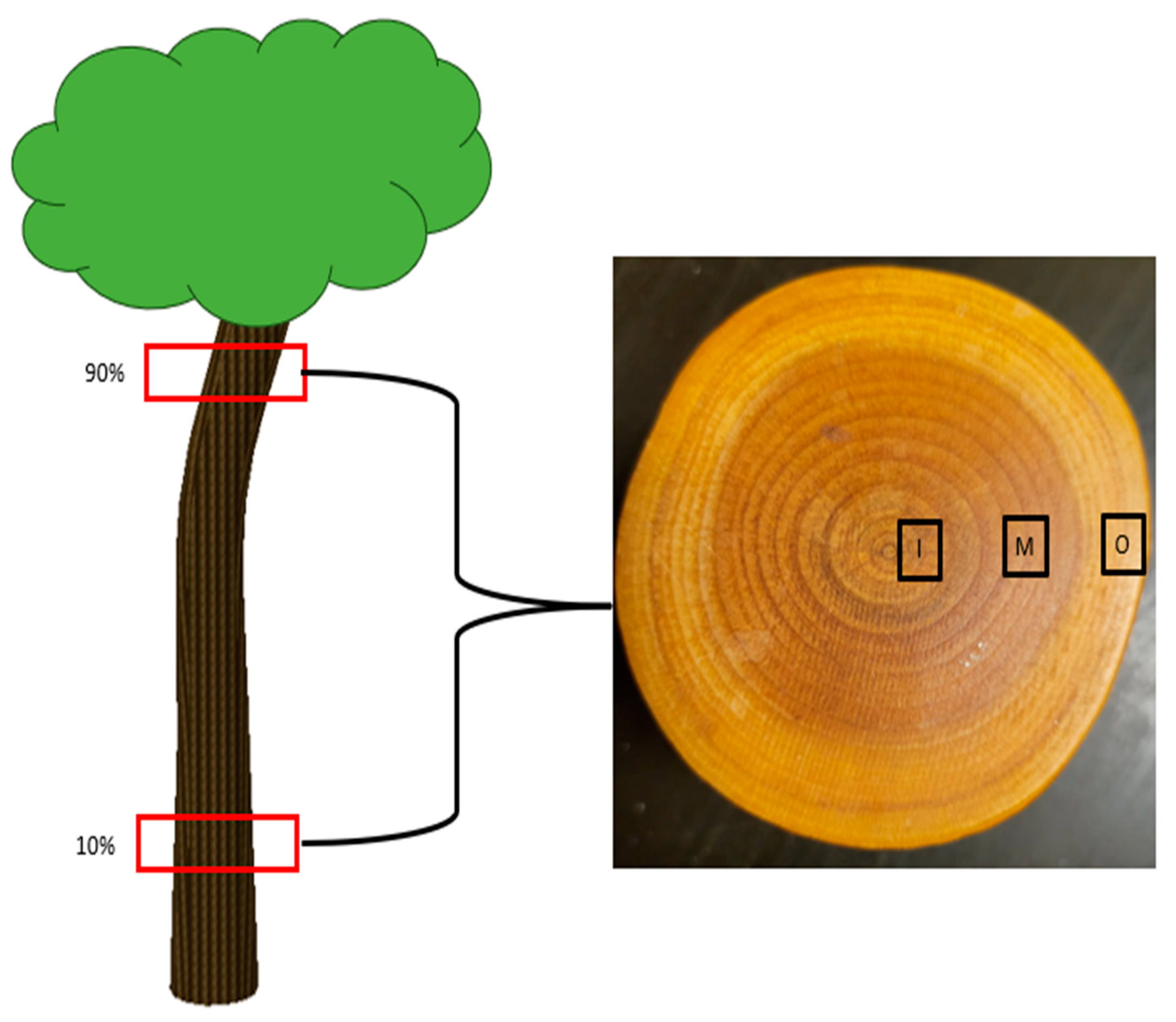

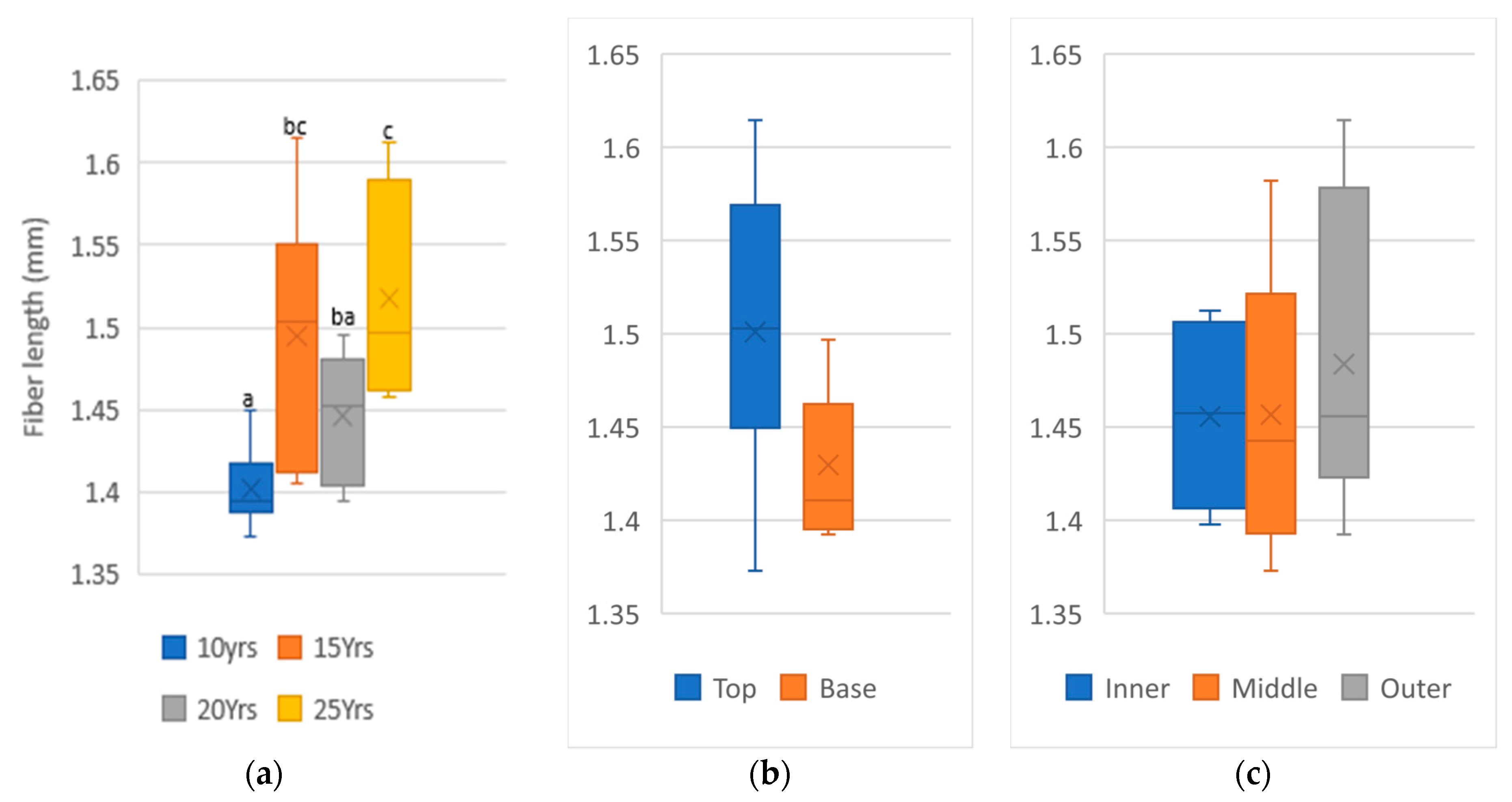
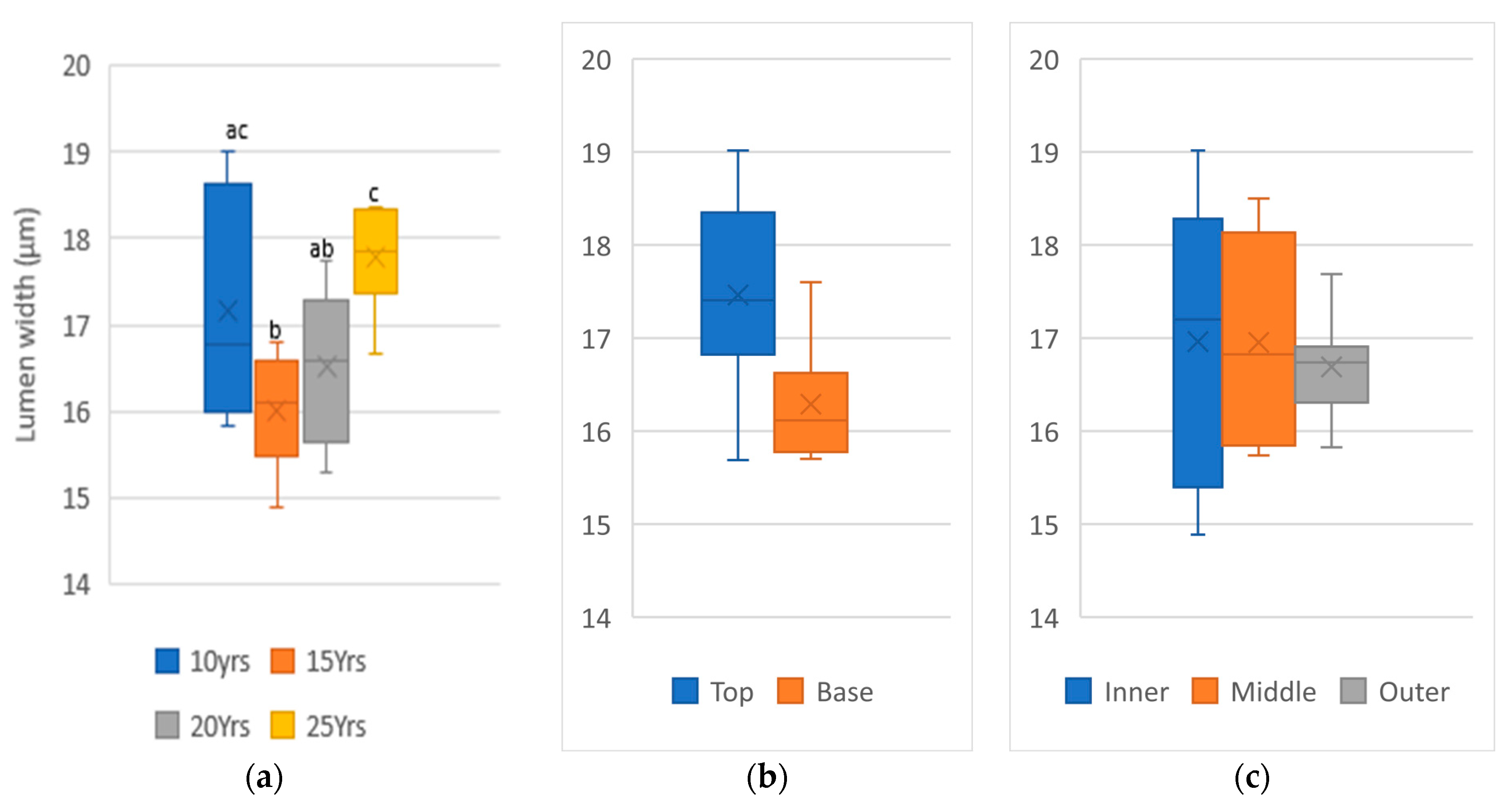
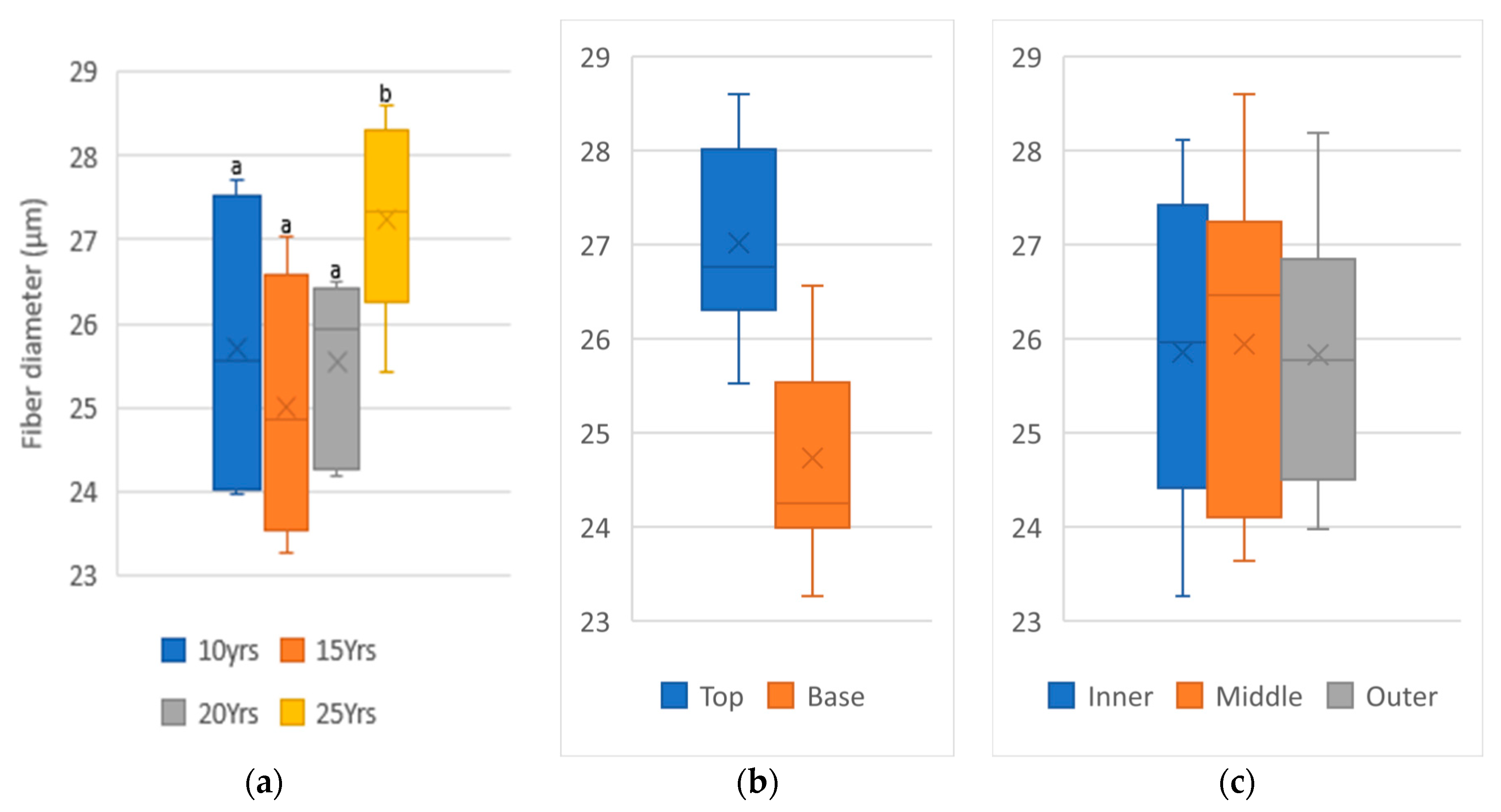
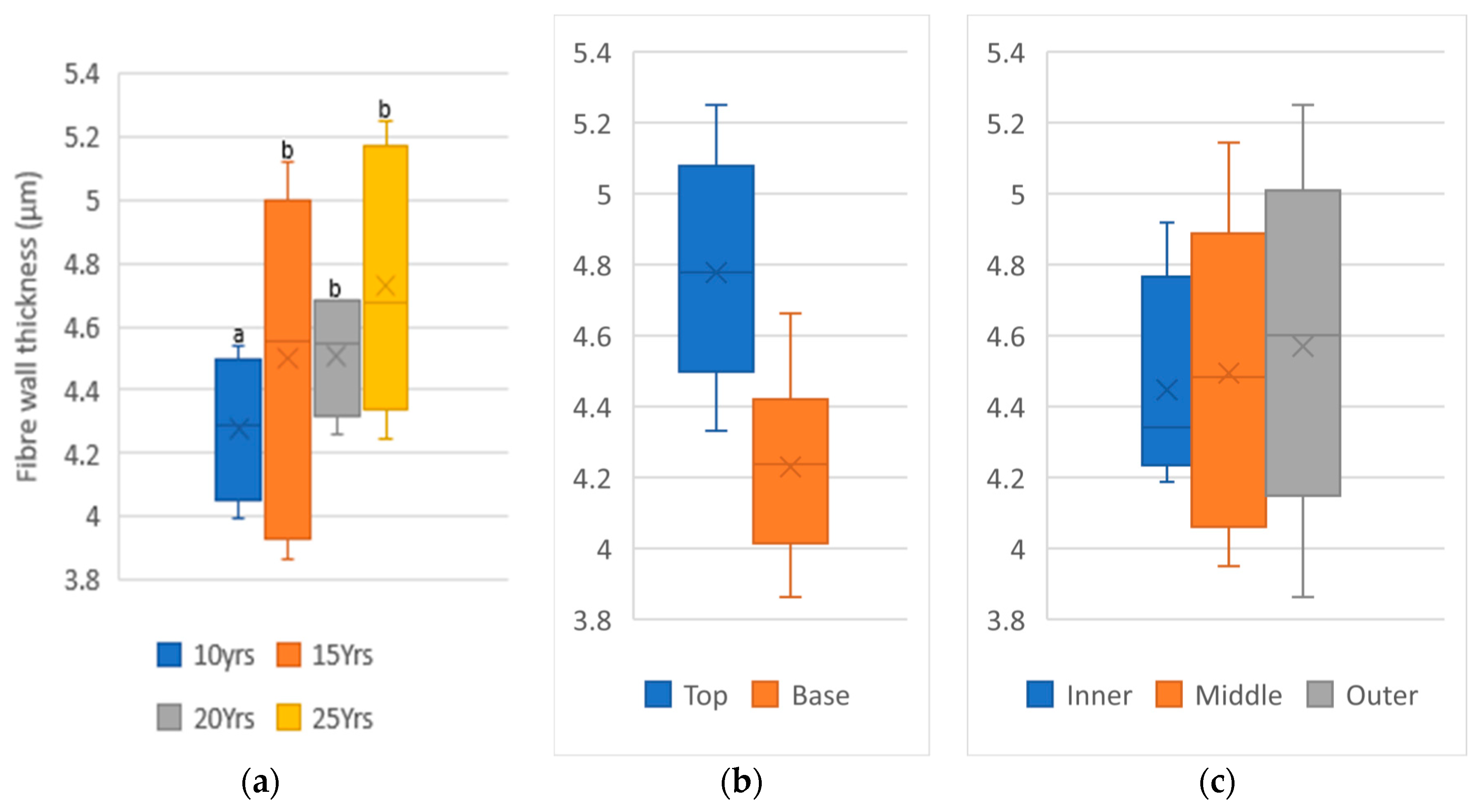
| Source of Variation | NumDF | denDF | Fibre Length | Lumen Width | Fibre Diameter | |||
|---|---|---|---|---|---|---|---|---|
| F-Value | p-Value | F-Value | p-Value | F-Value | p-Value | |||
| Tree age | 3 | 89 | 6.27 | 0.000635 | 5.69 | 0.00127 | 7.81 | 0.000105 |
| Height | 1 | 89 | 12.17 | 0.000745 | 13.41 | 0.000416 | 43.64 | 0.000000 |
| Radial position | 2 | 89 | 0.83 | 0.440 | 0.30 | 0.740 | 0.04 | 0.962 |
| Tree age * Height | 3 | 89 | 1.08 | 0.362 | 0.95 | 0.420 | 0.44 | 0.724 |
| Tree age * Radial position | 6 | 89 | 0.26 | 0.953 | 1.27 | 0.277 | 1.06 | 0.394 |
| Height * Radial position | 2 | 89 | 1.28 | 0.283 | 0.44 | 0.643 | 0.23 | 0.795 |
| Tree age * Height * Radial position | 6 | 89 | 0.53 | 0.781 | 0.27 | 0.948 | 0.33 | 0.919 |
| Source of Variation | NumDF | denDF | Fibre Wall Thickness | Slenderness Ratio | Flexibility Ratio | Runkel Ratio | ||||
|---|---|---|---|---|---|---|---|---|---|---|
| F-Value | p-Value | F-Value | p-Value | F-Value | p-Value | F-Value | p-Value | |||
| Tree age | 3 | 89 | 4.81 | 0.00369 | 6.58 | 0.000441 | 2.99 | 0.0359 | 2.827 | 0.0428 |
| Height | 1 | 89 | 44.42 | 0.000000 | 6.84 | 0.0104 | 3.51 | 0.0641 | 3.200 | 0.0769 |
| Radial position | 2 | 89 | 0.76 | 0.473 | 0.68 | 0.511 | 0.57 | 0.569 | 0.543 | 0.583 |
| Tree age * Height | 3 | 89 | 5.81 | 0.0011 | 0.98 | 0.407 | 4.61 | 0.00472 | 4.500 | 0.00540 |
| Tree age * Radial position | 6 | 89 | 0.52 | 0.789 | 1.11 | 0.361 | 1.05 | 0.395 | 1.014 | 0.421 |
| Height * Radial position | 2 | 89 | 1.54 | 0.220 | 1.35 | 0.265 | 1.31 | 0.274 | 1.280 | 0.283 |
| Tree age * Height * Radial position | 6 | 89 | 0.34 | 0.913 | 0.32 | 0.925 | 0.27 | 0.950 | 0.219 | 0.970 |
| Variables | Slenderness Ratio | Flexibility Ratio | Runkel Ratio | |
|---|---|---|---|---|
| Tree age | 10 Years | 55.04 a | 66.60 a | 0.50 a |
| 15 Years | 59.98 b | 64.06 b | 0.57 b | |
| 20 Years | 56.76 a | 64.56 b | 0.55 b | |
| 25 Years | 55.91 a | 65.26 ab | 0.54 b | |
| Height | Top | 57.99 a | 65.73 a | 0.53 a |
| Base | 55.90 a | 64.40 a | 0.56 a | |
| Radial position | Innerwood | 56.83 a | 65.33 a | 0.54 a |
| Middlewood | 56.50 a | 65.27 a | 0.53 a | |
| Outerwood | 57.58 a | 64.64 a | 0.55 a |
| Species | FL (mm) | LW (µm) | FD (µm) | CWT | Reference |
|---|---|---|---|---|---|
| Glirisidia sepium | 1.14 | 12.18 | 21.78 | 4.91 | [9] |
| Delonix regia | 1.34 | 26.83 | 39.42 | 6.49 | [9] |
| Senna siamea | 1.29 | 11.46 | 20.71 | 4.95 | [9] |
| Rhizophora racemosa | 1.76 | 18.92 | 36.09 | 8.58 | [7] |
| Rhizophora harrisonii | 1.54 | 17.55 | 34.25 | 9.45 | [7] |
| Tectona grandis | 1.73 | 15.6 | 29.47 | 7.89 | [6] |
| Rhicinodendron heudelotti | 1.36 | 32.3 | 41.5 | 4.6 | [8] |
| Triplochiton scleroxylon | 1.35 | 12.5 | 20.3 | [36] | |
| Gmelina arborea | 1.28 | 20.06 | 26.46 | 3.83 | [5] |
| Leucaena leucocephala | 0.65 | 9.87 | 15.67 | 2.9 | [4] |
| Ficus species | 0.99–1.28 | 14.85–20.99 | 18.69–28.93 | 1.94–4.99 | [5] |
| Hevea brasiliensis * | 1.4–1.52 | 16.02–17.78 | 25.02–27.23 | 4.28–4.73 |
Disclaimer/Publisher’s Note: The statements, opinions and data contained in all publications are solely those of the individual author(s) and contributor(s) and not of MDPI and/or the editor(s). MDPI and/or the editor(s) disclaim responsibility for any injury to people or property resulting from any ideas, methods, instructions or products referred to in the content. |
© 2023 by the authors. Licensee MDPI, Basel, Switzerland. This article is an open access article distributed under the terms and conditions of the Creative Commons Attribution (CC BY) license (https://creativecommons.org/licenses/by/4.0/).
Share and Cite
Onakpoma, I.; Ogunsanwo, O.Y.; Ohwo, O.A.; Raut, S.; Aguma, Q.; Schimleck, L.R.; Leavengood, S. Rubberwood—Potential for Pulp and Composite Board Utilization. Forests 2023, 14, 1722. https://doi.org/10.3390/f14091722
Onakpoma I, Ogunsanwo OY, Ohwo OA, Raut S, Aguma Q, Schimleck LR, Leavengood S. Rubberwood—Potential for Pulp and Composite Board Utilization. Forests. 2023; 14(9):1722. https://doi.org/10.3390/f14091722
Chicago/Turabian StyleOnakpoma, Ighoyivwi, Olukayode Y. Ogunsanwo, Oghenekevwe A. Ohwo, Sameen Raut, Queen Aguma, Laurence R. Schimleck, and Scott Leavengood. 2023. "Rubberwood—Potential for Pulp and Composite Board Utilization" Forests 14, no. 9: 1722. https://doi.org/10.3390/f14091722
APA StyleOnakpoma, I., Ogunsanwo, O. Y., Ohwo, O. A., Raut, S., Aguma, Q., Schimleck, L. R., & Leavengood, S. (2023). Rubberwood—Potential for Pulp and Composite Board Utilization. Forests, 14(9), 1722. https://doi.org/10.3390/f14091722









